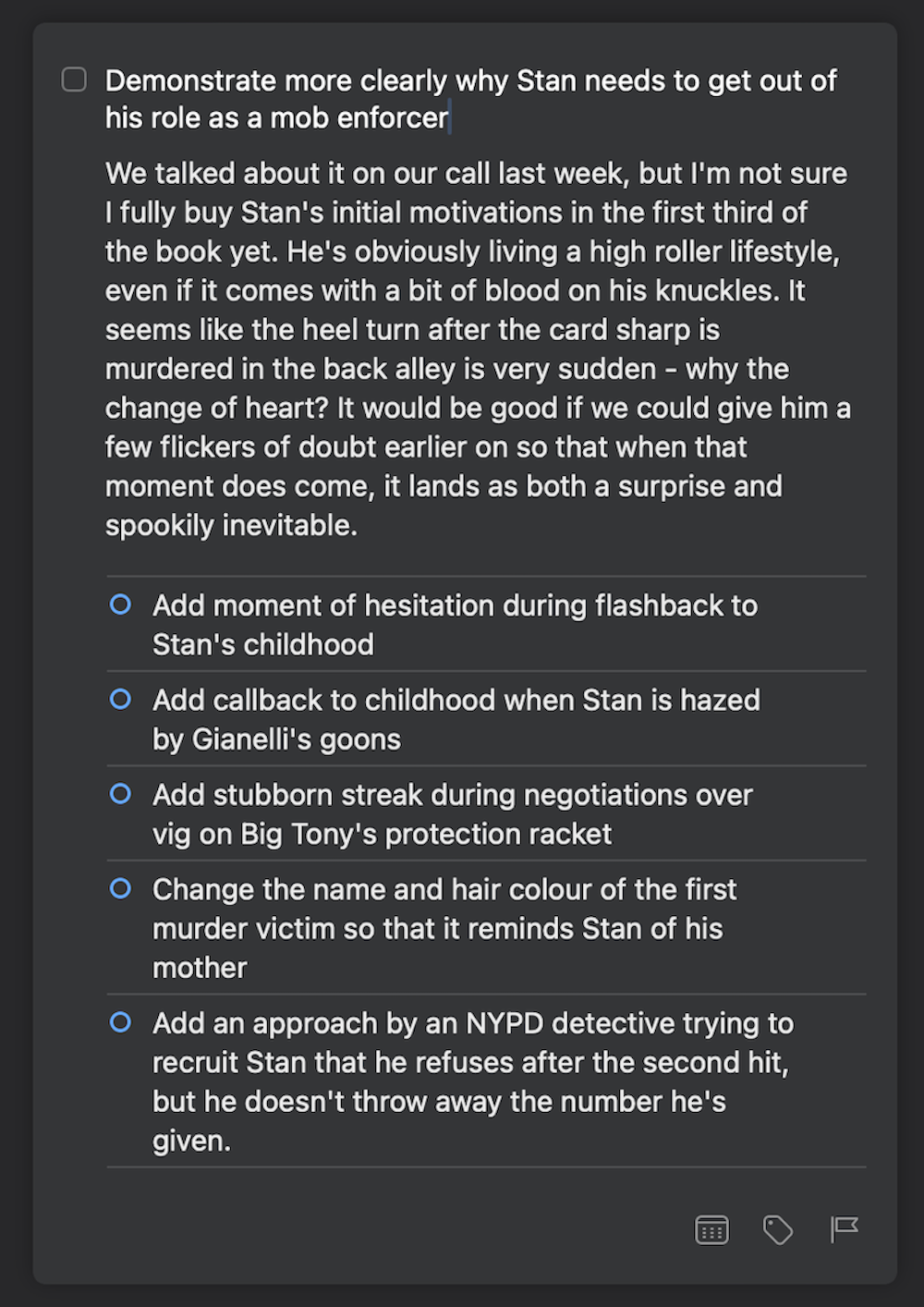How I tackle edit letters
Uh-oh. Your beta reader or agent or editor just dropped several pages of notes, ideas and 'minor tweaks' on you. What the hell do you do now?

One of my many online writing haunts is the fantastic subreddit PubTips, which is pretty much the best publicly available resource for querying writers. Indeed, I ran my own query letter through critique there and post semi-regularly when questions come up about the traditional publishing process. One such question came up the other day, when a user asked for tips on how to deal with their first edit letter from their editor. I commented on that thread, but after I'd finished typing out the process I use, I realised it might make a good foundation for this very blog post.
What is an edit letter?
'Edit letter' is a bit of a catch-all industry term. I'd imagine it originates from the days when people were literally mailing manuscripts to each other, but these days an edit letter can be anything from a (very) long email to a multi-page Word document attached to a shorter email. Depending on the source, they may be very detailed and paired with a marked-up manuscript, or they may be a few paragraphs and headings.
The first edit letters you'll work with will probably come from critique partners and beta readers who have read your whole book. Later, if you find an agent who is editorial, your first professional feedback will likely come from them and it will probably be in a long email and/or a call.
The most in-depth and possibly quite scarily structural edit letters will come from the folks with 'edit' in their job titles - your editor. These can range from genuinely 'a few small tweaks' to 'some fairly big changes', especially on your second or third or fourth book where (hopefully) you've gotten better at your craft but also your books are no longer running the merciless gauntlet of the querying process. And when they arrive, even those 'few small tweaks' type edit letters can seem like a massive, insurmountable task.
So how do you tackle an edit letter? I can't give you a surefire method, but I can tell you how I do it.
Assessing the scope
The first thing I do is to read the edit letter and accompanying email and scan through the comments in the manuscript (if there are any - sometimes line edit and structural/development comments are split into two separate stages, sometimes they're combined). I deliberately don't read it in any detail, just a quick scan through to get a sense of the big points. I'm trying to get a sense of the proposed changes, not react to them or think about them in any detail.
Then I don't do anything for 24 hours at least. If the immediate feelings this initial scan through raises in me are negative, I might stretch that to 48 hours.
This... percolation time is essential I think - even if you're able to emotionally detach yourself from a completed project to some degree, there's something very direct and personal about edit letters that can slip through that detachment and knife you in the ribs. I've learned the hard way that if I jump straight into coming up with responses or solutions to the problems and changes raised in the edit letter, I will probably waste a lot of time arguing in my head with all the competing emotions and conflicting ideas that I have in the heat of my initial response.
So I wait. And I try not to think about it. That's for my brain to do, in the background, while I do something else for a couple of days.
Planning the changes
The next step for me is to read everything in detail and plan out my changes. Edit letters, especially very long ones, can feel incredibly overwhelming at first. The most common reaction after 'I'm not sure I agree with half of this' is 'How the hell am I supposed to do all this?'. When you're dealing with an actual editor edit letter, there's quite often a time pressure too.
For me, planning my changes means two things - putting the things I have to do into my own words, then itemising what that actually means in terms of changing the manuscript.
Figuring out what to do
To do this, I create a bunch of tasks/cards in my todo list app (I go back and forth between Things for Mac, Kanban for Obsidian and sometimes just Reminders). In each card, I rephrase the big points from my agent/editor in my own words. I paste their original comment into the description of the task, but I always rephrase it in as short a sentence as I can.
For example, two or three paragraphs of detailed feedback about improving the main character's reasoning for something would be boiled down to 'Explain reasoning for MC's choice to do X'. Boiling it down to a single sentence really helps make it feel achievable. Because editors and agents are trying to be sensitive to their authors, their feedback is often phrased very gently, but coming up with a task I can actually do means cutting through that polite verbiage to the actual root of the issue.
This process turns three or four paragraphs of commentary that I initially read as 'here is a huge, amorphous, hard to comprehend reason your book is flawed' into a defined, executable editing task which has edges I can see.
Figuring out where to do it
Once I have the cards, I go through the original editorial feedback in each card and note anywhere they've specifically suggested I fix the issue. I add those as subtasks (in the diner conversation, when they're driving to Bristol, during the action scene on the rooftop). Then I'll have a bit of a think about other places I might want to make the same change or seed it into the draft in different ways and I add those as subtasks too.
Once I've done this task breakdown, I go through the line edits on the manuscript, accepting any straight typos or minor rephrasings I agree with, stetting or rewriting the odd one here and there (editors aren't always right about the solutions, but they're nearly always right about the problems). If anything is a reference to the Big Items on my tasklist I haven't already captured, I add it as another subtask.
What I end up with at this point is a 'clean' manuscript with the typos etc already done, plus a load of big cards/tasks with little checkboxes for each thing I need to do. That feels a lot more achievable than staring at a Word document for hours or days.
Making the edits
Then I pick one of the Big Items and start working through the changes. Because I have clarified the overall task and listed out the steps I need to take to make that change a reality, the actual work in front of me on any given editing day is achievable and realistic. Here's an example of what one of my editing cards might look like, on a fictional editorial comment for my (non-existent) neo-noir thriller Big Stan's Last Dance:

In an editing session of around 60-90 minutes, I will usually manage to complete one or two of these cards, with their various subtasks. Sometimes a card only has two or three subitems on it, sometimes it has a dozen. And sometimes those subitems are literally adding or removing a sentence, while other times they require a whole new scene. But the important part is that they are small, comprehensible steps I can take, one after the other. As I address each item, I also reply to the in-line comments in the manuscript itself, so I can see at a glance if I've dealt with it.
Then I rinse and repeat until I've checked everything off. This is actually my favourite part of the process now. With the benefit of outside, expert perspective, you can actually see the book getting better with each cut and change. Plus the process of breaking down the Big Items into doable units really calms me down and counters the feelings of grumpy refusal and overwhelmed anxiety that an edit letter can spark.
If you've got an edit letter coming soon, I hope this approach gives you some ideas for your own writing process. Some people keep all of this in their heads (I have no idea how) and some people get even more granular than me, with spreadsheets and post-it notes on whiteboards linked with red string. Do whatever works. But if you've never tried this kind of task breakdown, why not give it a go?
